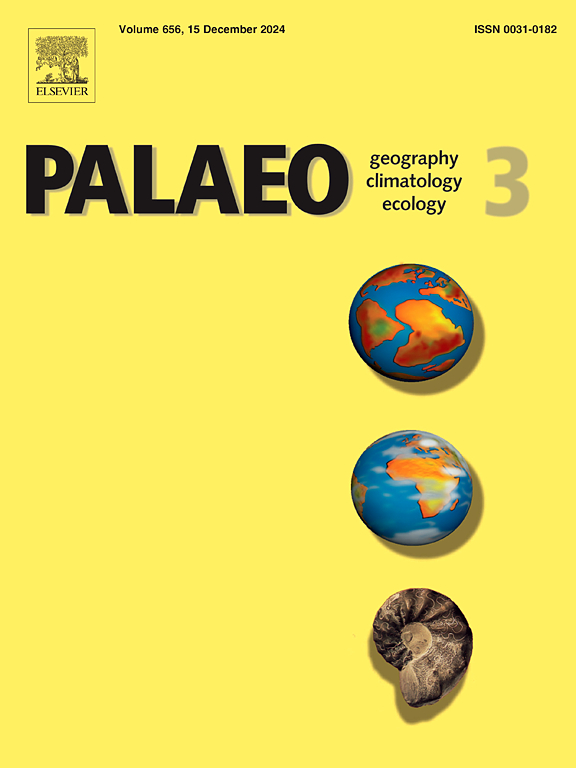南海北部湾盆地晚始新世区域水系演化的源-汇多代理分析
IF 2.7
2区 地球科学
Q2 GEOGRAPHY, PHYSICAL
Palaeogeography, Palaeoclimatology, Palaeoecology
Pub Date : 2025-06-03
DOI:10.1016/j.palaeo.2025.113081
引用次数: 0
摘要
涉及穿越岩石构造复杂地体的区域尺度流域的物源研究是具有挑战性的,特别是当相似年龄的锆石群分布在整个源区时。本文研究了南海西北部靠近扬子陆块、华夏陆块和印度支那陆块交界处的北部湾盆地晚始新世的演化过程。我们采用了基于锆石的多代理方法,将UPb测年、Hf同位素、U-Pb /裂变径迹双测年和沉积学证据结合起来,以了解源-汇路径。碎屑锆石年代学分析显示,西部和北部样品物源空间差异显著,分别存在单峰和多峰年龄。虽然这两个样本都含有大量的加里东时代,但仅根据年龄分布的统计分析来确定来源是不确定的。与北部样品相比,锆石Hf同位素和裂变径迹联合分析表明,西部样品可能来自扬子地块的宋蔡地块,而不是以往研究认为的来自华夏地块附近的云开地块。地震地层学研究表明,西部地区存在大规模的轴向三角洲斜形,这可能与西北地区起源于宋济地块的广泛古水系的发育有关。这种东南流的古水系可能是古红河和珠江支流的前身。这些发现验证了基于锆石的多代理分析有效地解决了不同地区物源复杂性,但强调了沉积学证据的整合对于进一步完善源-汇模型的重要性。本文章由计算机程序翻译,如有差异,请以英文原文为准。
A source-to-sink multiproxy analysis of late Eocene regional drainage evolution in the Beibuwan Basin of the South China Sea
Provenance studies involving regional-scale drainages that traverse lithostructurally complex terranes are challenging, especially if similar-aged zircon populations are distributed across source areas. In this paper, we study the late Eocene succession of the Beibuwan Basin in the northwestern part of the South China Sea, which is near the junction of the Yangtze, Cathaysia, and Indochina Blocks. We apply a zircon-based multiproxy approach that integrates U![]() Pb dating, Hf isotopes, and U–Pb/fission track double dating, and sedimentological evidence to understand source-to-sink pathways. Detrital zircon geochronology analysis reveals significant spatial provenance variation between western and northern samples, with unimodal and multimodal age peaks, respectively. Although both samples contain a large amount of Caledonian ages, provenance determination is uncertain based on the statistical analysis of age distributions alone. Compared with northern samples, combined zircon Hf isotope and fission track analysis suggest that western samples may have been sourced from the Song Chay Massif in the Yangtze Block, rather than from the nearby Yunkai Massif in the Cathaysia Block, as indicated by previous studies. Seismic stratigraphic studies indicate the existence of a large-scale axial deltaic clinoform in western areas, which may be linked to the development of an extensive palaeodrainage originating from the Song Chay Massif in the northwest. This southeast-flowing palaeodrainage was potentially a precursor to the palaeo-Red River and Pearl River tributaries. These findings validate that zircon-based multiproxy analyses effectively resolve provenance complexities in diverse regions, but emphasise that integration of sedimentological evidence is important to further refine the source-to-sink model.
Pb dating, Hf isotopes, and U–Pb/fission track double dating, and sedimentological evidence to understand source-to-sink pathways. Detrital zircon geochronology analysis reveals significant spatial provenance variation between western and northern samples, with unimodal and multimodal age peaks, respectively. Although both samples contain a large amount of Caledonian ages, provenance determination is uncertain based on the statistical analysis of age distributions alone. Compared with northern samples, combined zircon Hf isotope and fission track analysis suggest that western samples may have been sourced from the Song Chay Massif in the Yangtze Block, rather than from the nearby Yunkai Massif in the Cathaysia Block, as indicated by previous studies. Seismic stratigraphic studies indicate the existence of a large-scale axial deltaic clinoform in western areas, which may be linked to the development of an extensive palaeodrainage originating from the Song Chay Massif in the northwest. This southeast-flowing palaeodrainage was potentially a precursor to the palaeo-Red River and Pearl River tributaries. These findings validate that zircon-based multiproxy analyses effectively resolve provenance complexities in diverse regions, but emphasise that integration of sedimentological evidence is important to further refine the source-to-sink model.
求助全文
通过发布文献求助,成功后即可免费获取论文全文。
去求助
来源期刊
CiteScore
5.90
自引率
10.00%
发文量
398
审稿时长
3.8 months
期刊介绍:
Palaeogeography, Palaeoclimatology, Palaeoecology is an international medium for the publication of high quality and multidisciplinary, original studies and comprehensive reviews in the field of palaeo-environmental geology. The journal aims at bringing together data with global implications from research in the many different disciplines involved in palaeo-environmental investigations.
By cutting across the boundaries of established sciences, it provides an interdisciplinary forum where issues of general interest can be discussed.

 求助内容:
求助内容: 应助结果提醒方式:
应助结果提醒方式:


